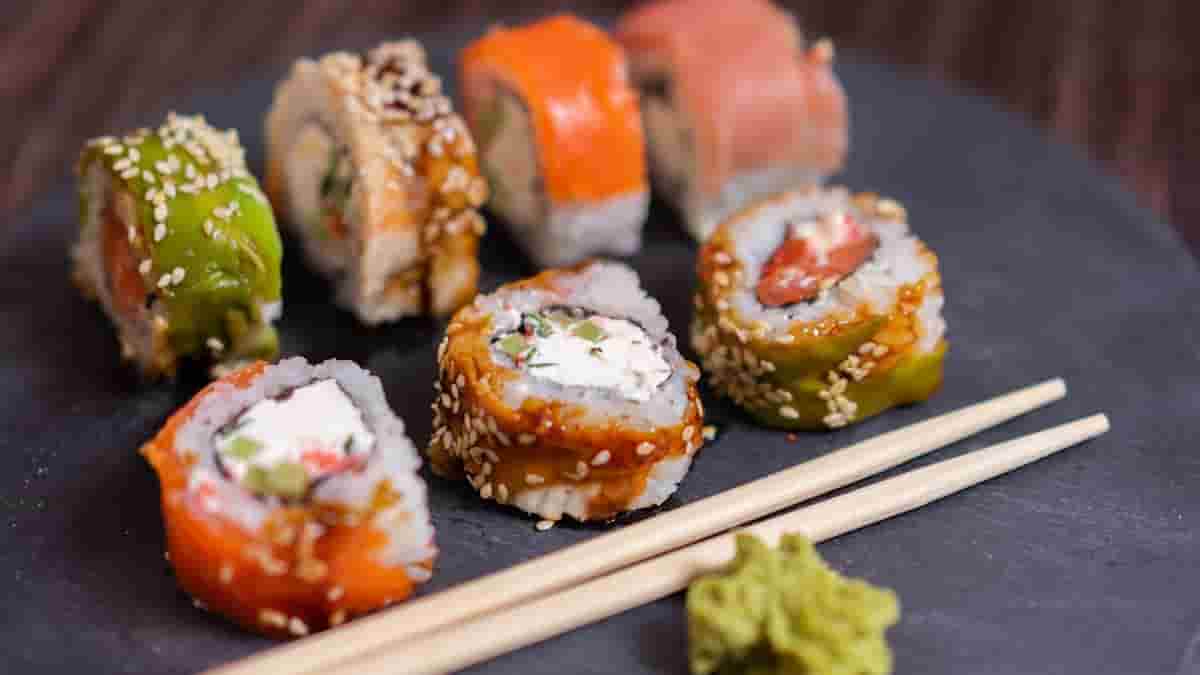Here is your complete guide to low sodium sushi meal recipes.
Introduction to Low Sodium Sushi Meal Recipes
Sushi is a beloved dish around the world, known for its fresh ingredients and unique flavors. However, traditional sushi can often be high in sodium, primarily due to ingredients like soy sauce and processed seafood. This article will explore the concept of low sodium sushi meal recipes, offering delicious alternatives that allow you to enjoy sushi without compromising your health.
In recent years, there has been a growing awareness of the importance of reducing sodium intake. High sodium consumption can lead to various health issues, including hypertension and heart disease. By opting for low sodium sushi meal recipes, you can indulge in this culinary delight while maintaining a healthier lifestyle.
In this article, you will find:
- An overview of what low sodium sushi is.
- Essential ingredients for making low sodium sushi.
- A variety of delicious recipes.
- Tips for enjoying sushi while dining out.
- Answers to frequently asked questions about low sodium sushi.
Let’s dive into the world of low sodium sushi meal recipes and discover how you can make this nutritious dish at home!
Understanding Low Sodium Sushi
Definition and Benefits
Low sodium sushi refers to sushi that is made with ingredients that are low in salt. This approach not only enhances the natural flavors of the ingredients but also makes it a healthier option for those looking to reduce their sodium intake.
Benefits of a Low Sodium Diet:
- Improved Heart Health: Reducing sodium can lower blood pressure and decrease the risk of heart disease.
- Better Kidney Function: Lower sodium intake helps kidneys function more effectively.
- Weight Management: Many low sodium foods are also lower in calories, aiding in weight control.
Common High Sodium Ingredients in Traditional Sushi
Traditional sushi often includes several high-sodium components:
- Soy Sauce: A common dipping sauce that can contain up to 1,000 mg of sodium per tablespoon.
- Processed Seafood: Some pre-packaged seafood may have added salt for preservation.
- Flavored Rice: Sushi rice is often seasoned with vinegar that may contain added salt.
By being aware of these ingredients, you can make informed choices when preparing your own low sodium sushi meal recipes.
Essential Ingredients for Low Sodium Sushi Meal Recipes
Creating delicious low sodium sushi meal recipes starts with selecting the right ingredients. Here are some essential components:
Rice Options
The foundation of any good sushi is rice. Here are some options:
- Short-Grain Brown Rice: A healthier alternative that adds fiber and nutrients.
- Sushi Rice: Opt for organic varieties without added salt.
Fresh Fish Selection for Low Sodium Sushi Meal Recipes
When choosing fish for sushi, consider:
- Salmon: Rich in omega-3 fatty acids and naturally low in sodium.
- Tuna: Another great option that is flavorful and healthy.
Vegetable Fillings for Low Sodium Sushi Meal Recipes
Adding fresh vegetables not only enhances flavor but also boosts nutrition:
- Cucumber: Adds crunch and hydration.
- Avocado: Creamy texture that pairs well with fish.
Nori and Seasoning Alternatives
Nori (seaweed) is essential for wrapping sushi rolls. Look for:
- Low Sodium Nori Options: Some brands offer nori without added salt.
For seasoning, consider these alternatives:
- Rice Vinegar: Use plain rice vinegar or make your own vinegar mix without salt.
Low Sodium Sushi Meal Recipes
Now that we have covered the essential ingredients, let’s explore some delicious low sodium sushi meal recipes!
1. Basic Sushi Rice Preparation
Ingredients
| Ingredient | Quantity |
|---|---|
| Short-grain rice | 2 cups |
| Water | 2 1/2 cups |
| Rice vinegar | 1/4 cup |
| Sugar | 1 tablespoon |
Instructions
- Rinse the rice under cold water until the water runs clear.
- Combine rice and water in a rice cooker or pot; cook according to instructions.
- Once cooked, let it cool slightly before mixing in rice vinegar and sugar.
- Stir gently to combine; set aside.
2. Classic Maki Rolls: Low Sodium Sushi Meal Recipes
Ingredients
| Ingredient | Quantity |
|---|---|
| Sushi rice | 2 cups |
| Nori sheets | 4 sheets |
| Fresh salmon | 100g |
| Avocado | 1 medium |
| Cucumber | 1 medium |
Instructions
- Prepare sushi rice as described above.
- Lay a nori sheet on a bamboo mat, shiny side down.
- Spread a thin layer of sushi rice over the nori, leaving a small border at the top.
- Place strips of salmon, avocado, and cucumber across the center of the rice.
- Roll tightly using the bamboo mat; seal the edge with a little water.
- Slice into bite-sized pieces and serve with low sodium soy sauce.
3. Vegetarian Sushi Rolls: Low Sodium Sushi Meal Recipes
Ingredients
| Ingredient | Quantity |
|---|---|
| Sushi rice | 2 cups |
| Nori sheets | 4 sheets |
| Carrot | 1 medium (julienned) |
| Bell pepper | 1 medium (sliced) |
| Avocado | 1 medium |
Instructions
- Prepare sushi rice as described earlier.
- Lay a nori sheet on a bamboo mat, shiny side down.
- Spread a thin layer of sushi rice over the nori, leaving a small border at the top.
- Add julienned carrot, sliced bell pepper, and avocado across the center of the rice.
- Roll tightly using the bamboo mat; seal with water as before.
- Slice into pieces and enjoy!
4. Sashimi Style Options
Sashimi is simply fresh fish served without rice or other accompaniments.
Ingredients
| Ingredient | Quantity |
|---|---|
| Fresh salmon | 200g |
| Fresh tuna | 200g |
Instructions
- Ensure fish is sashimi-grade (fresh and safe for raw consumption).
- Slice fish into thin pieces using a sharp knife.
- Serve on a plate with wasabi (optional) and low sodium soy sauce for dipping.
Dipping Sauces and Accompaniments: Low Sodium Sushi Meal Recipes
To enhance your low sodium sushi meal recipes, consider these sauces:
Low Sodium Soy Sauce Alternatives
Many brands offer low sodium soy sauce options:
- Kikkoman Low Sodium Soy Sauce: Contains about 575 mg of sodium per tablespoon compared to regular soy sauce’s 1,000 mg.
Pickled Ginger Recipe: Low Sodium Sushi Meal Recipes
Pickled ginger is often served with sushi but can be high in sugar:
Ingredients
| Ingredient | Quantity |
|---|---|
| Fresh ginger | 100g |
| Rice vinegar | 1 cup |
| Sugar | 1/4 cup |
Instructions
- Peel and thinly slice fresh ginger.
- In a saucepan, combine rice vinegar and sugar; heat until sugar dissolves.
- Pour over sliced ginger; let sit for at least an hour before serving.
Tips for Eating Out on a Low Sodium Diet: Low Sodium Sushi Meal Recipes
When dining out at sushi restaurants, here are some tips to keep your meal low in sodium:
- Ask for No Soy Sauce: Request your rolls without soy sauce or ask for low sodium options if available.
- Choose Sashimi: Opting for sashimi allows you to enjoy fresh fish without added sauces or seasonings.
- Inquire About Ingredients: Don’t hesitate to ask about how dishes are prepared; many restaurants will accommodate dietary requests.
Common Mistakes to Avoid When Making Low Sodium Sushi Meal Recipes
Creating delicious low sodium sushi meal recipes can be a rewarding experience, but there are several common mistakes that home cooks often make. By being aware of these pitfalls, you can enhance your sushi-making skills and ensure your dishes are both tasty and healthy.
1. Using High Sodium Ingredients
One of the most significant mistakes is incorporating high sodium ingredients into your sushi.
- Soy Sauce: Regular soy sauce is notoriously high in sodium. Instead, opt for low sodium soy sauce or use it sparingly.
- Processed Fish: Many pre-packaged seafood options contain added salt. Always choose fresh, sushi-grade fish to keep sodium levels low.
- Flavored Rice: Traditional sushi rice is often seasoned with salt. Make your own by using plain rice vinegar and avoiding added salt during cooking.
2. Not Choosing the Right Type of Rice
Using the wrong kind of rice can affect both the texture and flavor of your sushi.
- Sushi Rice: Always use short-grain Japanese rice (shari) that is sticky enough to hold together when rolled. Avoid instant or long-grain rice varieties.
- Rinsing Rice: Failing to rinse the rice thoroughly can result in excess starch, which may lead to a gummy texture. Rinse until the water runs clear.
3. Overstuffing Sushi Rolls
Overstuffing your sushi rolls can lead to messy outcomes and difficulty in rolling.
- Ingredient Balance: Use a thin layer of each ingredient and leave about an inch of nori free at the top to seal the roll properly.
- Portion Control: Aim for about five scoops of rice for each roll, ensuring a balanced ratio of rice to fillings.
4. Ignoring Food Safety Practices
Food safety is crucial when preparing sushi, especially when using raw fish.
- Sushi-Grade Fish: Always use high-quality, sushi-grade fish that is safe for raw consumption. Look for reputable sources and ask about their handling practices.
- Proper Storage: Keep fish refrigerated until you’re ready to use it, and consume sushi shortly after preparation to avoid foodborne illnesses.
5. Neglecting Flavor Balance
Maintaining a good balance of flavors is key to delicious sushi.
- Wasabi Usage: Instead of mixing wasabi directly into your rolls, apply it on the side when eating to avoid overpowering the other flavors.
- Seasoning Rice: Season your rice properly with vinegar and a hint of sugar to enhance its flavor without adding salt.
By avoiding these common mistakes, you can create low sodium sushi meal recipes that are not only healthier but also bursting with flavor. Enjoy the process of making sushi at home while ensuring that each bite is both satisfying and nutritious!
Frequently Asked Questions (FAQs) about Low Sodium Sushi Meal Recipes
What is considered low sodium in sushi?
Low sodium generally means containing less than 140 mg of sodium per serving according to FDA guidelines.
Read Also: Low Sodium Tofu Recipes.
How can I make sushi without soy sauce?
You can use alternatives like low sodium soy sauce or simply enjoy sashimi with no sauce at all.
Read Also: Detox Smoothie with Cucumber.
Are there any health risks associated with high sodium sushi?
Yes, excessive sodium intake can lead to hypertension, heart disease, and other health issues.
Read Also: Soft Tofu Recipes Stomacache.
Conclusion
Incorporating low sodium sushi meal recipes into your diet allows you to enjoy this delicious cuisine while prioritizing your health. With simple ingredient swaps and creative recipes, you can make flavorful sushi at home that satisfies your cravings without compromising on taste or nutrition.
Read Also: Strawberry Ricotta Filling Recipe.
So gather your ingredients, roll up your sleeves, and start experimenting with these recipes today! Enjoy your journey into the world of healthy eating through delicious low-sodium options!
Read Also: High Fiber Yogurt Parfait Recipe.

